== 3.14. Prove l'Hôpital's rule in the following form. Suppose f(a) = f'(a) = f(n-1) (a) = 0, g(a) = g'(a) = == g(n-¹)(a) = 0, and either f(n) (a) #0 or g(n) (a) #0 (or both); then f(x) lim x-a g(x) 8 f(n) (a) g(n)(a) if g(n) (a) = 0, otherwise. (Suggestion: Use Taylor's formula with Lagrange's form of the remainder, for both f(a+Ax) and g(a + Ax).)
== 3.14. Prove l'Hôpital's rule in the following form. Suppose f(a) = f'(a) = f(n-1) (a) = 0, g(a) = g'(a) = == g(n-¹)(a) = 0, and either f(n) (a) #0 or g(n) (a) #0 (or both); then f(x) lim x-a g(x) 8 f(n) (a) g(n)(a) if g(n) (a) = 0, otherwise. (Suggestion: Use Taylor's formula with Lagrange's form of the remainder, for both f(a+Ax) and g(a + Ax).)
Algebra & Trigonometry with Analytic Geometry
13th Edition
ISBN:9781133382119
Author:Swokowski
Publisher:Swokowski
Chapter4: Polynomial And Rational Functions
Section: Chapter Questions
Problem 5T
Related questions
Question

Transcribed Image Text:==
3.14. Prove l'Hôpital's rule in the following form. Suppose f(a) = f'(a) = ..
f(n-1)(a) = 0, g(a) = g'(a) = ... = g(n-1)(a) = 0, and either f(n) (a) #0 or
g(n) (a) #0 (or both); then
f(x)
lim:
x→a g(x)
∞
f(n) (a)
g(n) (a)
if g(n)(a) = 0,
otherwise.
(Suggestion: Use Taylor's formula with Lagrange's form of the remainder, for
both f(a+Ax) and g(a + Ax).)
Expert Solution
This question has been solved!
Explore an expertly crafted, step-by-step solution for a thorough understanding of key concepts.
Step by step
Solved in 2 steps

Recommended textbooks for you

Algebra & Trigonometry with Analytic Geometry
Algebra
ISBN:
9781133382119
Author:
Swokowski
Publisher:
Cengage


Functions and Change: A Modeling Approach to Coll…
Algebra
ISBN:
9781337111348
Author:
Bruce Crauder, Benny Evans, Alan Noell
Publisher:
Cengage Learning

Algebra & Trigonometry with Analytic Geometry
Algebra
ISBN:
9781133382119
Author:
Swokowski
Publisher:
Cengage


Functions and Change: A Modeling Approach to Coll…
Algebra
ISBN:
9781337111348
Author:
Bruce Crauder, Benny Evans, Alan Noell
Publisher:
Cengage Learning

Trigonometry (MindTap Course List)
Trigonometry
ISBN:
9781337278461
Author:
Ron Larson
Publisher:
Cengage Learning